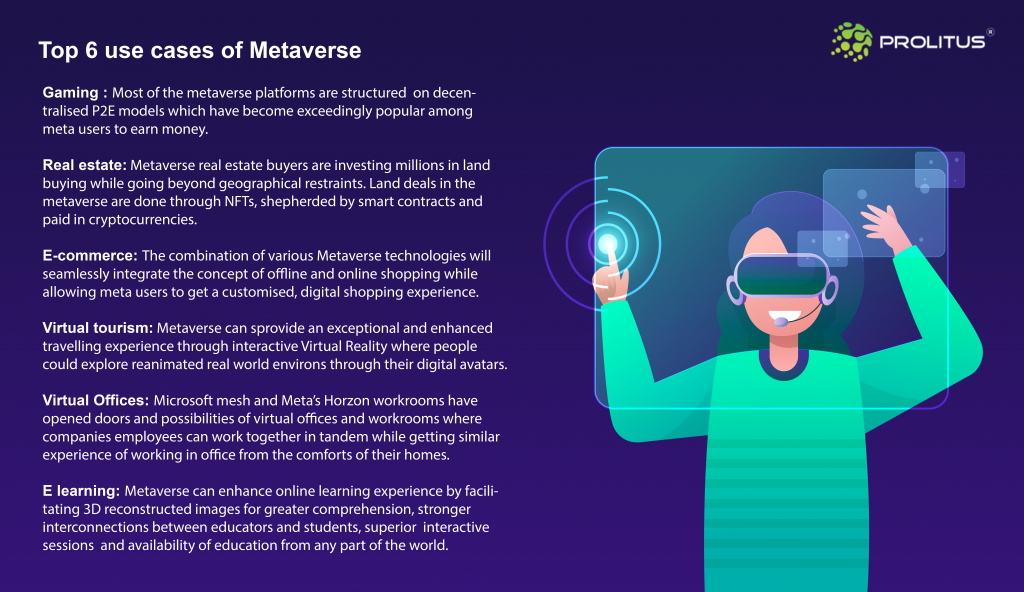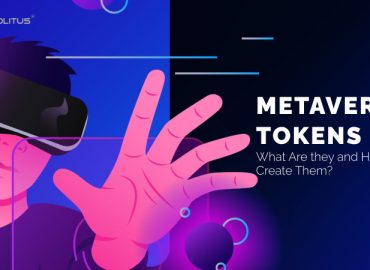Take a real tour of the virtual world of the Metaverse, with an explanation of the various facets of this technological wonder with elucidating steps to create a metaverse platform.
How does it feel to be away from your family and friends for an extended period? A little over a decade ago, the best we could do was make calls and stay in touch. But as technology evolved, we got the luxury of video calling, which is, for now, our best bet to connect with our loved ones. However, accommodating video calling is yet one still feels bereft because it’s not the same as meeting in person. Now, let’s say you call up home and find a party going on and you feel left out, leaving you solely disappointed. But what if there was a technology that allowed you to attend that party? Not just attend but interact and meet the party-goers and experience the moment as if you were physically present. People would have chalked this scenario down as a science fiction fantasy a decade ago. However, today we know this technology as Metaverse.
What is metaverse: History and Evolution
Metaverse is an amalgamation of two words. “Meta” is a Greek word that means beyond, and “Verse” represents the universe. Metaverse is a collective virtual shared space that hosts digital avatars of people where they interact with each other. It is a 3D world within computers conceptualized using virtual reality, augmented reality, artificial intelligence, NFT technologies, blockchain, and others. This immersive technology takes its users into a virtual, augmented universe where they can experience and execute a myriad of activities such as shopping, playing games, attending office meetings, holding fashion shows, doing business, exploring space, and ad infinitum.
Do? Want to know the difference between multiverse and metaverse? Read our article on Metaverse vs Multiverse
In retrospect, virtual reality isn’t a new concept and, in fact, has been advocated through literature and movies for decades. Although the word “metaverse” was first used by the author Neal Stephenson in his 1992 cult science fiction novel “Snow Crash.” The book mainstreamed the idea of a virtual, dystopian world where people adorn a virtual avatar and enter virtual reality as a means of escapism using virtual and augmented reality headsets.

Twenty-nine years later, after the release of Snow Crash, Mark Zuckerberg announced his company’s Facebook name change to Meta in 2021. In the founder’s letter, he spoke of an immersive technology that people will not just connect with but feel and experience things like in the physical realm. Then, through a video presentation, Zuckerburg explained how Metaverse would give people the power to move from one place to another through holograms. So imagine attending the office and then seamlessly jumping through a hologram to your home and then jumping across to attend a concert, all within one virtual platform or perhaps across meta platforms.
Such a scenario would be attainable through an assortment of devices; augmented reality glasses that allow you to be present in the real world and 3D glasses to experience virtual reality while using smartphones and computers to walk through various virtual scenarios.
Not only Facebook but giants like Microsoft, Google, and Apple view Metverse as the succeeding technology of the internet.
The Cinematic world has long been exploring the concept of the Metaverse through movies like Ready Player One and Jumanji. In addition, shows like Westworld, Altered Carbon, and Black Mirror have brought forth the idea of a 3d virtual world that exists within the internet and the futuristic possibilities that entail with this immersive Metaverse technology in its advanced avatar.
Examples of metaverse platforms
Currently, metaverse exists mostly in online gaming platforms such as Sandbox, Roblox, and Minecraft. The prime example is Pokemon Go, based on augmented reality, which took the world by storm in which players were catching virtual pokemon left, right, and center.
However, at Connect 2021, Mark Zuckerberg shared his company’s vision to incorporate Metaverse in different sectors such as gaming, Messenger calling in VR, and fitness. Apart from Meta, other tech companies are developing various platforms based on use cases other than online games and their company’s vision. Let’s look at some popular metaverse use cases through the following examples and how conglomerates like Meta, Google, Decentraland, etc., integrate various technologies to create metaverse platforms.
- A sandbox game: Developed over Ethereum blockchain, Sandbox gaming is set in the virtual world where the players get to create their digital avatars and their own gaming universes. They can even monetize their gaming experience using Sandbox digital currency called SAND. It started as a 2D pixel mobile game and eventually evolved into a 3D form. Recently, the company launched a new version of the game called alpha season 2, where players will be able to buy virtual land, create NFTs, and compete against each other for sandbox tokens.
- Meta’s Horizon Worlds: Similar to Microsoft’s Minecraft and Roblox, Horizon is an interactive online video game that allows gamers to create their own digital spaces, hang out with others, and play online games.
- Star Atlas: A futuristic VR P2E (play to earn) game set in the metaverse where players assume digital avatars of space travelers, scientists, engineers, commanders, pirates, etc., intending to discover new planets and their hidden treasures.
- Bloktopia: It is a metaverse skyscraper platform with 212 levels as an ode to 21 million bitcoins, the maximum supply of the most famous cryptocurrency. Users also referred to as Bloktopians, will trade NFTs to buy real estate, lease properties, and much more.
- Silks NFT: Silks is an upcoming 2022 P2E metaverse project focused on thoroughbred horse racing. In this metaverse platform, players will be able to buy digital avatars and own digital avatars of real thoroughbreds. Silks horses. The whole platform is structured as an NFT marketplace which includes digital horses, stables, and lands as tradable NFTs. The project owners plan to include two tokens, $SLK as a Dao Governance token, and the other is $STT as P2E rewards token.
Blockchain in metaverse
There are two aspects of any technology:
- Hardware: Metaverse hardware comprises equipment such as haptic gloves, AR/VR glasses, sensors, VR headsets, VR gloves, wrist-based bands, and controllers.
- Software: Most of the metaverse platforms are Blockchain-based. Blockchain is a disruptive web3 technology that allows interoperability, immutability, transparency, and data sharing between nodes residing in any part of the world. Blockchain is also the technology behind cryptocurrencies and NFT development, so it shouldn’t be a surprise that this ledger technology is used to build the Metaverse platform.
As blockchain forms the basis of this immersive technology, let’s look at the various features of Metaverse that are seeded from the ledger technology. These characteristics are, for instance, imperative for hologram travel or facilitating seamless travel between various metaverse platforms.
- Interoperability: People seek similar feasibility in the metaverse world for the continuity and ease of traveling from one place to the other in the physical world. Metaverse interoperability means interactions between various projects, accessing and sharing resources, trading, multi-platform social interactions, and a single wallet for storing cryptocurrencies and executing transactions across meta platforms.
- Interactivity: The metaverse will allow meta users interaction and socialize like in the physical world. Users’ exploits would be similar to that of the actual world as they will get to experience simulated encounters.
- Persistence: Metaverse is a continuing technology that will keep existing with no chance of shutting down like other conventional applications and remains forever integrated with the real world.
Other technologies for a metaverse
As we know that to create metaverse platforms, combinations of technologies are put to use. So let’s have a look at other technologies involved:
- AR ( Augmented reality) is a magnified representation of the physical world using technology’s sensory elements such as vision, sound, and touch.
- VR or Virtual reality is a computer-generated simulation of 3D environments or images for users to interact using virtual reality gadgets such as VR goggles and VR headsets.
- MR or Mixed Reality combines virtual reality and augmented reality while blurring the lines between the physical and digital world.
- AI or Artificial intelligence has a very important role in building the meta world, be it developing digital avatars, translating human languages to machine language, data storage, etc.
- BCI or brain-computer interface is a type of human-machine interface that enables humans to communicate with machines without any physical contact between the two. BCI detects brain waves and uses them to control the machine. Online games using BCI are already in the web domain, Pacman, Awakening, and World of Warcraft, to name a few. Inarguably, this cutting-edge technology has a crucial role in building metaverse platforms.
- NFT technologies: NFTs are digital tokens created over a blockchain. In metaverse, users can mint various NFTs such as land, digital clothing, avatars, and whatnot. With the help of digital wallets, NFTs will be interoperable across various meta worlds.
- 3D reconstruction technology: Using 3D tech, digital spaces can be created in the metaverse to represent real space. Meta users will be able to take virtual tours of these 3D reconstructed spaces in their digital avatar. For instance, users could tour a 3d model of a fashion store in the metaverse and move around, explore, and even try out apparel in their digital avatar. Their experience in the metaverse is as close as in the physical world.
- IoT or Internet of Things: From collecting data from the physical world to connecting the virtual 3D world to hardware devices, IoT is another crucial technology that has a diversified role to play in the metaverse.
Why are major brands investing in Metaverse?
Metaverse is the hottest commodity currently in the crypto industry. Though still in the nascent stage, it continues to attract almost all of the major tech and mainstream users worldwide. They recognize the future potential of this evolving digital ecosystem and are getting into the metaverse realm and looking to invest now and reap the benefits in the future proactively. According to industry pundits, the metaverse industry’s market size is projected to be worth an astounding 1 trillion dollars. So explains the mad rush why everyone is falling over themselves to create their own platforms and metaverse projects.
How to build your own metaverse platform
Now that we know what metaverse is, its growing importance in web 3.0, and the technologies associated with building a metaverse platform. It’s time to dig deeper and understand what it entails in creating this immersive world.
Here are the steps to create your metaverse platform:
- Pick and choose your metaverse platforms and use case
The first step is to choose the appropriate metaverse platform, as in, you may decide to either create a metaverse app or space. Once the platform is decided, the next step is selecting a use case. There is no dearth of metaverse platforms already in action, such as marketplaces, interactive games, real estate trading, virtual tourism, office spaces, fashion, education, and others. However, you may decide to pick niches already in play or decide to create a metaverse platform with a new use case, such as the upcoming 2022 silks project.
- Designing and developing a robust metaverse platform
The next few steps are crucial as they involve designing and developing a platform based on the selected use case. Following are the steps to build a metaverse platform.
- Research and analysis: Before hiring the required professionals, you must research the competition, study market trends, and zero in on end-users. The data collected is then analyzed by the project managers and the core team to determine the technology required for the project execution.
- Hiring metaverse professionals: Metaverse is still an evolving technology, and therefore it requires technology specialists to develop and design an interactive 3D platform. For instance, coders proficient in Javascript are required to develop AR and VR-based applications. Similarly, for NFT metaverse projects, you would require blockchain experts and NFT developers. You need to hire UI/UX designers to design a user interface.
Let’s take an example of Meta’s Horizons project. To develop this platform, developers need to be familiar with the following 3D tools:
- Unreal Engine: Highly advanced open 3D creation tool to create virtual projects
- Unity application: A user-friendly, complete 3D application to develop 3D games for various devices such as mobiles, laptops, etc.
- Programming languages: Metverse developers with proficiency in C# and C++, which are the programming languages required for Unreal and Unity engines, respectively.
The software programmers write both front-end and back-end application codes while melding extrinsic services such as digital wallets.
- Choosing blockchain for platform development: There are several blockchains to choose from for metaverse development, such as the evergreen Ethereum or newly developed Solana and Polygon. Choose a blockchain best suited to your project.
- Coding metaverse smart contracts: The next step requires developing a smart contract, which refers to any preset contract to create or enable a decentralized metaverse functionality. For instance, if you wish to buy land in Decentraland, smart contracts are coded to operate trading processes related to land deals. Token standards like ERC-721 and ERC-1155 are used to develop smart contracts.
Let’s understand, from an example, the coding process of a smart contract for a gaming platform using the ERC-721 token. The coding process for gaming includes assembling, importing, developing, and setting up smart contract fundamental features. Then process code to record various traits and functions of the characters within the gaming platform. Finally, the smart contract is deployed by using developer tools like Remix.
Besides front and back-end applications and smart contracts, other metrics also need to be considered for developing a fully functional metaverse platform, which is as follows:
- Developing an IPFS storage system
- Creating a database for information storage
- Developing cloud infrastructure and framework
- Testing the final product: Next step involves testing the developed platform, which quality analysts do. Their job is to locate and fix bugs and check the final product’s features and functionality, reliability, and technical compliance.
- Deploying the beta version: The final step involves deploying the bug-free beta version on cloud servers. For mobile applications, the developed app is released through mobile app stores such as Google Play, Apple store, Amazon store, etc.
- Post-launch support system: Simply launching the developed metaverse project is not the end game. The platform still undergoes a series of test runs due to the complexity of the project. The project is tested for user response and the probable addition or removal of applications at this stage. The support system also collects usable feedback to enhance the platform and make it more user-friendly.
Cost of creating a metaverse platform
Tech giants have invested billions of dollars in developing the technologies meant for the metaverse. For example, Mark Zuckerberg has pledged to invest $3 billion in metaverse projects. However, creating your own metaverse platform can be a costly affair mainly because it is a relatively new technology. In addition, there are comparatively fewer people with the technological know-how required for developing a metaverse platform.
Hardware for metaverse is pretty expensive; one VR headset costs hundreds of dollars. Other than hardware, developing a metaverse platform requires skilled software professionals, hardware technicians and creators, management teams, and other employees. Additionally, infrastructure costs and overheads also need to be included.
Considering everything, the cost of building a metaverse platform can run into millions of dollars depending upon the scope and magnitude of a project.
Potential benefits, challenges, and future of the metaverse
Ever since the evolution of the digital era, we have witnessed technological innovations moving at a rapid pace. As a result, we live in a world where the lines between virtual and physical worlds have begun to blur. The metaverse has taken it up a notch with its immersive technology powered by various cutting-edge technologies.
Technologies are ridden with both positive and challenging aspects, and the metaverse is no different. So first, let’s talk about the benefits of this immersive technology that has the world in its grip.
- High-quality entertainment: Online gaming stands to benefit most from the metaverse. The VR and AR technologies have vastly improved the gaming experience, and gaming in the 3D environment provides an unforgettable experience to gamers giving them an almost real-life experience.
- Create more jobs and business opportunities: Already, many tech giants, business houses, and individuals are investing heavily in building decentralized metaverse platforms, effectively bringing metaverse into the mainstream. Therefore, there is a huge demand for metaverse specialists and other tech experts required to build meta platforms. We can only see the demand for these experts surging in the future, thereby creating more job opportunities as more and more businesses seek to hire these metaverse professionals.
- Increased social interactions: Metaverse will facilitate easier social interactions between people. The recent pandemic severely affected social interaction as people were forced to live in their homes. Imagine a group of friends meeting in a virtual world and partying, eating, drinking, and dancing together just like they would in the physical arena. Metaverse can make this possibility a reality where people, through their digital avatars, get to do all the activities like in the real world. It doesn’t matter in which part of the world you are located. Just log in to a meta world and meet your friend over a cup of coffee. How cool would that experience be!
- Benefits to the Work environment: Whether it’s Meta’s Horizon workrooms or the Microsoft Mesh project, they both have one similarity. They both are centralized metaverse platforms where employees of the respective companies could meet, interact, work on projects, and hold virtual meetings and conferences, all through their digital avatars. Meta developed Oculus VR headsets for their Horizon workrooms to aid socializing and working of their employees. Through Mesh, Microsoft employees would be able to connect through holographs, share space and collaborate with their work teams from anywhere in the world, all from the comforts of their homes. The pandemic has made many companies rethink their working styles, and metaverse could immensely contribute to creating hybrid working models.
- Benefits to education and E-learning: Education was one sector that was hugely impacted by the pandemic affecting the education of millions of children worldwide. Many children would have lost out on years of education if it weren’t for platforms like Zoom and Google Meet. Now think how metaverse will facilitate and enhance online learning giving children the luxury to join the network from whichever part of the world they live in. It will also provide an immersive experience of lessons that could be digitally recreated in the meta world.
- Investments opportunities for financial profits: Through the metaverse, users could venture into various investment opportunities like investing in real estate, playing games to earn tokens, holding virtual concerts, virtual tourism, NFT exchanges, and many more.
With every new emerging technology comes a set of challenges and drawbacks that make us take a step back, rethink our strategies, and reset our attitudes towards such immersive technologies as the metaverse. Here are some of those challenges listed below.
- Loss of reality: A technology as hypnotic as metaverse can make one lose the sense of reality. The concept allows easy movement between the real and physical world, leading to feelings of estrangement. Too much time in the meta world may essentially make people cut off from the physical world and lead to addiction. People, especially kids and teenagers, will tend to get addicted to the virtual world and may lose their sense of reality in extreme cases.
- Effects on mental health: We are already experiencing the effects on mental health due to excessive use of social media, where the young generation is practically glued to their phones. Children as young as four are dealing with issues like depression, anxiety, sleep disorders, impaired cognitive functions, and low self-esteem. Think what technology like the metaverse could do to such young, impressionable minds. According to psychologists, spending excessive time in the metaverse could lead to severe psychosis as users, especially the younger lot could lose their cognitive ability to distinguish between the real and the virtual world.
- Privacy and security problems: Recently, Meta and google faced a severe backlash regarding data security or lack of it. These tech giants have been accused of data leaks and data scandals, so it’s an open-ended question about how data security and privacy concerns will be addressed by the tech companies developing metaverse platforms. Also, as a new technology, metaverse will likely be subjected to cyber threats and could become a hub of illegal activities.
- Massive computing power requirements: Creating 3D ecosystems requires astronomical amounts of computing power and electricity to develop high-caliber projects.
- Huge costs: Undertaking a metaverse project requires huge investments, mainly due to the usage of advanced and expensive technologies. Then there are logistics to be considered, such as production costs, workforce, and continuous in-house and outbound support; maintenance costs can cost a pretty penny to the developers. One can comprehend from the recent investments in projects like Bloktopia, where $4.2 million were raised as seed capital while Sandbox bagged a $94 million investment in round 2.
- Lack of metaverse professionals: As metaverse is fairly a new concept, finding hardware and software professionals adept in 3D and related technologies is an uphill task. Either bigger fishes lap up existing tech experts, or their services come at an exorbitant price.
How the metaverse will transform the future
Amidst all the said benefits and challenges, one could not ignore the fact that the future era belongs to the virtual world of the metaverse. Several companies worldwide developing 3D-enabled technologies, and the sheer number of investments on roll corroborates that Metaverse is likely to be the dominating technology by the turn of this decade. The mainstreaming of this immersive technology is already in the domain with its usage in sectors like real estate and eCommerce. Amazon and Decentraland have already taken it up a notch higher with activities like virtual shopping, virtual real estate tours, and fashion shows.
Recently, Amazon introduced an AI-based Virtual Dressing room app that allows users to try clothes virtually. Furthermore, Dolce and Gabbana organized a metaverse fashion week hosted by Decentraland, where they dropped their first metaverse clothing line and introduced their exclusive NFT called DG Family.
The examples mentioned above testify that the metaverse has already and undisputedly taken over our daily lives. If Zuckerberg’s predictions are to be believed, the metaverse will soon fully integrate itself into our everyday lives, completely blurring the lines between the virtual and real world. Furthermore, with the number of projects already on the ground and more in the offing, metaverse will no longer be a rich man’s domain but most likely become a common person’s dominion.
Why choose Prolitus for metaverse platform development?
If you are looking to build an enterprise-grade decentralized metaverse platform, then Prolitus is up for the challenge as we are already proficient in everything that constitutes web3.0, and metaverse is no different. Moreover, we have a seasoned team of indigenous tech professionals who proactively involve themselves in a P2P process – from planning to post-launch of a sustainable, scalable, and user-friendly metaverse platform. So why not choose a Prolitus as your partner in creating the project of your dreams? So no more procrastinating and get in touch with our efficient and courteous Prolitus support team and get to know more about our metaverse development services.





